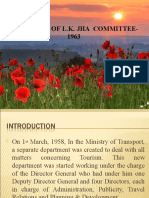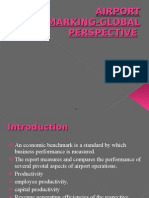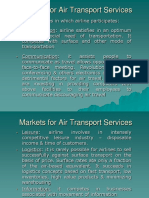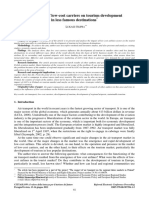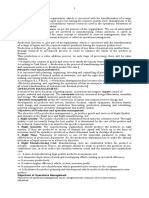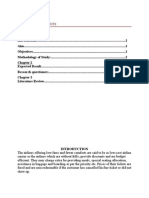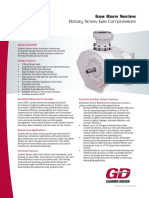Birmingham Airport Case Study
Birmingham Airport Case Study
Uploaded by
Riya DograCopyright:
Available Formats
Birmingham Airport Case Study
Birmingham Airport Case Study
Uploaded by
Riya DograOriginal Title
Copyright
Available Formats
Share this document
Did you find this document useful?
Is this content inappropriate?
Copyright:
Available Formats
Birmingham Airport Case Study
Birmingham Airport Case Study
Uploaded by
Riya DograCopyright:
Available Formats
Case Study Birmingham International Airport In the space of just 30 minutes every weekday, around 5.
00 in the evening, around 20 flights arrive and depart from the Eurohub Terminal. At the same time, aircraft are arriving and leaving from the Main Terminal next to the Eurohub. Across the runway and acres of tarmac, at the site of the original airport, the overnight freight operation is just beginning to wake up with the arrival of staff and the preparations for the first aircraft from Europe or the United States. Some of the 7,000 staff from the 150 organisations based at Birmingham International Airport (BIA) see to the needs of their customers. The baggage handling operation is sorting, checking and dispatching bags to the many departing aircraft. The ground crews are loading and unloading aircraft, putting meals on board, filling the fuel tanks and cleaning aircraft during their brief spell at the airbridge. The airlines ticketing staff are dealing with lines of passengers, each of whom may have a different final destination. The information desk is fully staffed, dealing with the many queries, such as people wanting to know if their plane is on time, the location of a bank or hotel, or trying to work out how to get by road or rail to their final destination. Passengers flow through the lounges, passport control and security checks, and use toilets, duty free shops and restaurants, all of which have to be kept clean and stocked for their convenience. All of these activities, and more, are coordinated by BIAs Operations Director, Richard Heard. Richard explains his role: Out of all the people that work at the airport, BIA employs about 700 and I oversee about 600 of them. These operations people are basically concerned with the day-to-day running of the airport and the short and medium-term operational planning. This includes a whole raft of things on the airfield and in and around the terminals. The air-field side of things essentially involves maintaining the runways, agreeing slot allocations with the airlines, developing and implementing the safety management systems and keeping the fire crews fully trained. For example, this is a heavily regulated area so we work very closely with the Civil Aviation Authority. The other side of the operation is about managing the terminal buildings and other facilities. This is almost like running a shopping centre with its focus on customer service but with special security arrangements. Airport security is a key task which we run in-house, employing about 300 people. I also have a facilities management team and an engineering services team that look after the maintenance of the whole site. In terms of long-term design and development, we set up teams to oversee the planning of new building projects, such as new catering outlets, car parks and people mover systems. This plan uses the forecasts of passenger numbers and guides our decisions about what to build and when, and how to pay for it. We have been growing at a rate of about 10 per cent a year over the last 10 years. In 2000 the airport handled 7.6 million passengers and our growth is set to continue, with an anticipated 10 million passengers expected to travel through Birmingham by 2005. This plan involves serious money; we are talking about a capital plan of about 50 million a year over the next 15 years. This is all very much driven by operational needs. Managing and developing the airports operations are huge challenges. One of the major tasks for operations is not just to provide the infrastructure for all the other organisations on site such as airlines, handling agents, retailers, cargo handlers but also to provide the leadership and coordination for them. There are also groups off site, such as community
groups, which we liaise with as we work to monitor and improve the environment. My personal job is about coordination and setting the safety and customer service standards for everyone to adhere to. All of us from the different organisations try to work together as a team and there is a great community spirit here that has built up over the years. Everyone wants their own bit to work well and the whole thing to work well together. We all have a great understanding of everyones problems and there is an excellent spirit of cooperation. The real secret of managing operations, if you are ever going to sleep at night, is to make sure you have really good processes and procedures in place. We cant have people making it up on the spot. Everything has to be thought through and tried and tested. We spend a great deal of time reviewing and developing processes. We have to have procedures for fires, evacuations, bomb threats, ill passengers and even deaths in the terminal. Unfortunately, we do have medical emergencies, not surprising since we have about 30,000 people passing through the airport every day in the summer. Another key task is operational planning. We do this on an annual basis. Operational planning is about making the operation as efficient as possible by working out how we can best allocate our infrastructure to the airlines. For example, we need to decide who is going to get the airbridges, who is going to get certain stands, who is going to have their passengers bussed to the terminal at peak times and so on. However, you have to remember that the operational plans are just that and as ever, things go wrong schedules fall apart because of plane delays or mechanical problems, for example. So we also have terminal duty managers whose job it is to sort out the dayto-day operational problems. Our team of terminal managers covers the airport 24 hours a day, every day of the week, with one senior manager overseeing each shift. Many of the things that happen are recurring problems, such as delays or diversions and you know you will end up with a lot of passengers waiting around a lot longer than they want to. The job of the duty manager is to coordinate all our efforts, ensuring that the catering people know whats happening and making sure our information services people know so they can tell the passengers, for example. The terminal managers need to keep their own ears and eyes open. Passengers may report that they have seen someone acting suspiciously and the managers need to know what to do. When passengers get off the plane and their bags are not there, although its the responsibility of the airlines or their handling agents, our people may have to pick up the pieces. When people try taking prohibited items through security, such as a family heirloom with a large curved blade, we have to explain patiently to them that they have to leave it with us. The terminal managers also have to deal with major incidents things like bomb threats or, like last year, when Spanish coach drivers went on strike leaving many passengers stranded at the airport. The job of the terminal manager is to sort it all out and make sure everyone knows what is happening. It involves a great deal of common sense but it is not easy. If you do an evacuation, for example, everyone will be at different stages in the passenger processing and security clearance procedures, so when the incident is over, we have to try and put them all back where they came from without mixing them up or making them start the process again! We have the equivalent of the terminal duty managers looking after the airfield side: operations duty managers. Their job is about dealing with the day-to-day problems, such as changing stand allocations when delays occur or arranging snow clearance if we have a sudden fall. Again plans are in place and everything has to be thought through. We also have weekly communication
meetings when we get the operations and duty managers to work with the operational planning department. Our mission is to be the best regional airport in Europe. To do this we need continually to try and improve everything we do. It sounds simple, but it is not easy. For example, we have almost no capacity at peak times, that is between 7.00 a.m. and 8.00 a.m. and between 5.00 p.m. and 6.00 p.m. when we are busy with short-haul European traffic, so we are trying to encourage other airlines to fill in the off-peak times. This is ideal for long-haul operators and we now have flights to South East Asia and America, and just last year we added an Emirates flight to Dubai. This allows us to use the middle of the day when we have runway and terminal capacity and it suits everybody as we can all make better use of our facilities. Running an airport is a fascinating and exciting challenge. No two days are the same. We know that we can make a real difference to our customers, both passengers and airlines, by what we do. We also make a major contribution to the impact on the local economy by encouraging inward investment and exports. As an operations manager, my job is to make it all happen. Its a fantastic opportunity and it really does make a difference its great! Questions 1. Identify the micro-operations to be found at the airport. For each one: a) Identify the transforming and transformed resources b) State what is the predominate transformed resource c) Describe the output of each micro-operation and say who you think its customers are 2. Summarise the job of the operations director. What are the main issues/problems he faces in managing the airport? 3. What do you think Richard Heard actually does each day (how does he spend his time)? 4. Discuss the relationship between the day-to day tasks and the long-term issues and explain how Richard manages to oversee both at the same time
You might also like
- Case Study 1 - Birmingham International AirportDocument4 pagesCase Study 1 - Birmingham International Airportloohuilan68% (25)
- Port and Airport Management For LogisticsDocument2 pagesPort and Airport Management For LogisticsTHOR -No ratings yet
- Florida Vehicle Registration: Alvarez, Jose Fernando 5800 SW 127TH AVE UNIT 2320 MIAMI, FL 33183Document1 pageFlorida Vehicle Registration: Alvarez, Jose Fernando 5800 SW 127TH AVE UNIT 2320 MIAMI, FL 33183Jose Alvarez0% (1)
- Modes of TransportationDocument6 pagesModes of TransportationJeet100% (1)
- Terex TA25Document4 pagesTerex TA25Ersin SucuNo ratings yet
- 4059-Ca-00213956 - 1 Riser Installation AnalysisDocument110 pages4059-Ca-00213956 - 1 Riser Installation AnalysisSettha YoosomsookNo ratings yet
- Module 2 - Passenger Terminal OperationsDocument46 pagesModule 2 - Passenger Terminal OperationsBhaskar SaileshNo ratings yet
- Production and Operation Management OperationDocument13 pagesProduction and Operation Management OperationEngr Ibad RazzakNo ratings yet
- Airline and Airport ManagementDocument10 pagesAirline and Airport ManagementGuna Seelan GNo ratings yet
- L.K. JHA Committee 2Document10 pagesL.K. JHA Committee 2Vikas Kumar100% (4)
- Familiarization of Airport PartsDocument22 pagesFamiliarization of Airport PartsShane VinceNo ratings yet
- Case Study Birmingham International AirportDocument6 pagesCase Study Birmingham International AirportRoderick sidamonNo ratings yet
- Birmingham International AirportDocument7 pagesBirmingham International AirportSameh SalahNo ratings yet
- Case Report On Birmingham Intl AirportDocument5 pagesCase Report On Birmingham Intl AirportbhjbhjkNo ratings yet
- Birmingham International AirportDocument3 pagesBirmingham International Airportgufronat0% (1)
- Case StudyDocument4 pagesCase StudysiuyinxddNo ratings yet
- Ma Notes 2016Document124 pagesMa Notes 2016Denis OdhiamboNo ratings yet
- Airport OperationsDocument14 pagesAirport OperationsSyeda Azka AliNo ratings yet
- GRCCCM NOTES Aviation Management IntroductionDocument24 pagesGRCCCM NOTES Aviation Management IntroductionchandanNo ratings yet
- Service Innovation Impact To Customer Value Enhancement of Clark International AirportDocument72 pagesService Innovation Impact To Customer Value Enhancement of Clark International AirportPaula CatchuelaNo ratings yet
- Aerotropolis: The New Emerging Urban Form: Airports and The Evolution of Cities: An OverviewDocument4 pagesAerotropolis: The New Emerging Urban Form: Airports and The Evolution of Cities: An OverviewAakritiNo ratings yet
- Birmingham International AirportDocument14 pagesBirmingham International AirportNeneTchania100% (2)
- Advantanges and Disadvantages of The Modes of TransportationDocument4 pagesAdvantanges and Disadvantages of The Modes of TransportationNathalie Sofia Caballero NietoNo ratings yet
- Suvarnabhumi Airport ProjectDocument14 pagesSuvarnabhumi Airport ProjectslusafNo ratings yet
- Sydney 2000 Olympic Games: A Project Management PerspectiveDocument6 pagesSydney 2000 Olympic Games: A Project Management PerspectiveAD R0% (1)
- Export Import Documentation and Logistics AssignmentDocument8 pagesExport Import Documentation and Logistics AssignmentSekla ShaqdieselNo ratings yet
- Airport Terminals and Ground Access Part 2Document13 pagesAirport Terminals and Ground Access Part 2Abdul HannanNo ratings yet
- Climate and TourismDocument26 pagesClimate and TourismAnkit Gaur100% (2)
- Strategic Management at Emirates AirlinesDocument27 pagesStrategic Management at Emirates AirlinesYalda Kaviani100% (2)
- Airport FacilitiesDocument15 pagesAirport FacilitiesDamy Manesi100% (4)
- BBA Sem 4 MIS Notes Unit OneDocument23 pagesBBA Sem 4 MIS Notes Unit OneAbhishek AryaNo ratings yet
- Industry Analysis of Travel and Tourism IndustryDocument8 pagesIndustry Analysis of Travel and Tourism Industrysharadsingh23100% (2)
- Industrial Internship ReportDocument33 pagesIndustrial Internship ReportUrgie KuNo ratings yet
- TQM PracticesDocument11 pagesTQM PracticesMelvin Dxb MyDubaiNo ratings yet
- Heathrow Airport Case Study New - AshxDocument9 pagesHeathrow Airport Case Study New - AshxJim Taubitz100% (1)
- Air Port Operations (Land Side)Document16 pagesAir Port Operations (Land Side)adeel shahzad100% (1)
- One of The Micro-Operations Is Maintenance of The Whole Site. Maintransformed Resources AreDocument2 pagesOne of The Micro-Operations Is Maintenance of The Whole Site. Maintransformed Resources AreMuhammad Haseeb HassanNo ratings yet
- Land TransportationDocument79 pagesLand TransportationRocel LomedaNo ratings yet
- Nepal AirlinesDocument14 pagesNepal Airlinesanand bhagatNo ratings yet
- International BusinessDocument128 pagesInternational BusinessManoj Yadav100% (1)
- 3 - The Internal EnvironmentDocument49 pages3 - The Internal EnvironmentAdie FakhriNo ratings yet
- Cargo Services Export & Import Shed: Unit - 3Document23 pagesCargo Services Export & Import Shed: Unit - 3Nambi RajanNo ratings yet
- Airport ResearchDocument15 pagesAirport ResearchDessa TauroNo ratings yet
- Operation ManagementDocument7 pagesOperation Managementmarlon stylesNo ratings yet
- 0316airports and Airport Systems - Organization AdministrationDocument23 pages0316airports and Airport Systems - Organization AdministrationOladunni AfolabiNo ratings yet
- British Airways (BA) Is The: SWOT AnalysisDocument16 pagesBritish Airways (BA) Is The: SWOT AnalysisAntonio Annicchiarico RenoNo ratings yet
- SpicejetDocument21 pagesSpicejetvishnumenon27890No ratings yet
- Transportation Systems and Logistics Management PDFDocument46 pagesTransportation Systems and Logistics Management PDFmanjupadma75% (4)
- Airport Master PlanDocument34 pagesAirport Master PlanTmanNo ratings yet
- A Minimum Cost Design For An Automated WarehouseDocument284 pagesA Minimum Cost Design For An Automated Warehousekutsay100% (1)
- Emirates CrapDocument11 pagesEmirates CrapAnoop PrasadNo ratings yet
- Organization and Administration of An Airport - 2020Document23 pagesOrganization and Administration of An Airport - 2020Ruvinya HerathNo ratings yet
- Airport Bench Marking - Global PerspectiveDocument29 pagesAirport Bench Marking - Global Perspectiverathneshkumar67% (3)
- Markets For Air Transport ServicesDocument26 pagesMarkets For Air Transport ServicesMohasin85100% (1)
- The Impact of Low-Cost Carriers PDFDocument16 pagesThe Impact of Low-Cost Carriers PDFSohaib Ejaz100% (1)
- Activity1. Opt and ManagementDocument5 pagesActivity1. Opt and Managementdra_gonNo ratings yet
- Airline Industry Marketing MixDocument27 pagesAirline Industry Marketing MixAnuran Gayali100% (3)
- Ryanair Strategy 2 - 5 PagesDocument5 pagesRyanair Strategy 2 - 5 Pagessickpuppy100% (1)
- Introduction To Operations ManagementDocument14 pagesIntroduction To Operations ManagementrajeeevaNo ratings yet
- Low Cost Airlines PROJECT: RYANAIR V/S AIRBERLINDocument13 pagesLow Cost Airlines PROJECT: RYANAIR V/S AIRBERLINROHIT SETHINo ratings yet
- MGMT 32 Case StudyDocument2 pagesMGMT 32 Case StudyRotsen SebiosNo ratings yet
- Birmingham International AirportDocument7 pagesBirmingham International AirportRosel Ann CariboNo ratings yet
- EconomicsDocument4 pagesEconomicsnikki.dahal2021No ratings yet
- Workhorse Chassis - GuideDocument232 pagesWorkhorse Chassis - GuidejjmokieNo ratings yet
- Cylinder Liner - Install: Disassembly and AssemblyDocument4 pagesCylinder Liner - Install: Disassembly and AssemblysatyaNo ratings yet
- Dissertation Martin WinterkornDocument4 pagesDissertation Martin WinterkornPaperWritingServiceUK100% (1)
- Wooden Pallet PDFDocument1 pageWooden Pallet PDFAnonymous JFKhjQyZOz0% (1)
- Simon's Sample EssaysDocument57 pagesSimon's Sample EssaysNguyễn Ngọc HươngNo ratings yet
- UKP ANT III 846 - DikonversiDocument79 pagesUKP ANT III 846 - DikonversiIlham pratama SaputraNo ratings yet
- Bid DocumentsDocument50 pagesBid DocumentsKevin MoraldeNo ratings yet
- FZS150 BlueDocument57 pagesFZS150 Blue江庭君No ratings yet
- Bosch Pocket Scan Obd1000 Manual Bilingual-CodesDocument60 pagesBosch Pocket Scan Obd1000 Manual Bilingual-CodeshansondrewNo ratings yet
- Barometer Check Form1Document1 pageBarometer Check Form1Boyan StoyanovNo ratings yet
- A Policy Paper - Overspeeding in A Blind Curve Road Leads To AccidentDocument2 pagesA Policy Paper - Overspeeding in A Blind Curve Road Leads To AccidentRodenjade CadungogNo ratings yet
- The New India Assurance Co. LTDDocument3 pagesThe New India Assurance Co. LTDsarath potnuriNo ratings yet
- Macro PerspectiveDocument19 pagesMacro PerspectiveShenavel UbasNo ratings yet
- Types of VesselsDocument34 pagesTypes of VesselsDiana OtáloraNo ratings yet
- IndexDocument4 pagesIndexJesus D. Gutierrez G.No ratings yet
- Saludo, Jr. V CA (Basco)Document2 pagesSaludo, Jr. V CA (Basco)Erika FloresNo ratings yet
- Yitayou EsheteDocument112 pagesYitayou EsheteMulugeta DessieNo ratings yet
- 205-03 Front Drive Axle and Differential - General Procedures - Differential Draining and FillingDocument5 pages205-03 Front Drive Axle and Differential - General Procedures - Differential Draining and FillingCARLOS LIMADANo ratings yet
- Driver Experience Log: Practice Is ImportantDocument2 pagesDriver Experience Log: Practice Is ImportantCamille GibbNo ratings yet
- TC 35Document2 pagesTC 35thiago.fcouto23No ratings yet
- Rotary Screw Gas CompressorsDocument2 pagesRotary Screw Gas Compressorsgheantika100% (1)
- Gujarat Technological University: Page 1 of 4Document4 pagesGujarat Technological University: Page 1 of 4Dipika GuptaNo ratings yet
- A Study of Helicopter CrashResistant Fuel Systems PDFDocument170 pagesA Study of Helicopter CrashResistant Fuel Systems PDFmartin81vette100% (1)
- SK Chapter 8 1 Model Estimates Slab CulvertsDocument95 pagesSK Chapter 8 1 Model Estimates Slab CulvertsQudratullah ShaikNo ratings yet
- Transportation ManagementDocument85 pagesTransportation ManagementAgumas Kindu100% (1)
- 12 7 20 Kenworth RecallDocument1 page12 7 20 Kenworth RecallhaneNo ratings yet
- ENGEN DYNAMIC DIESEL 500 PPMDocument1 pageENGEN DYNAMIC DIESEL 500 PPMWitbaasNo ratings yet









